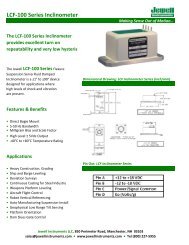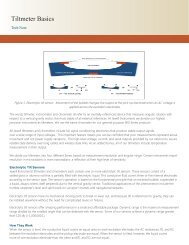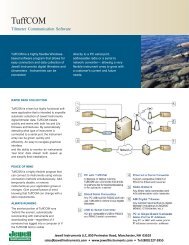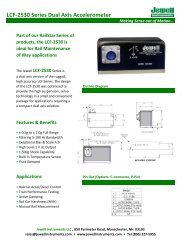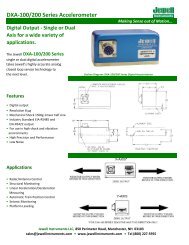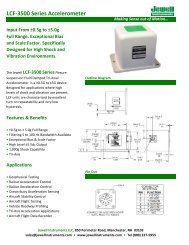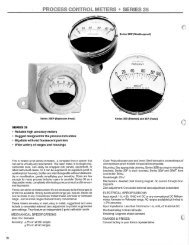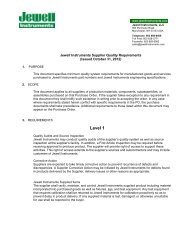Sensors Catalog - Jewell Instruments
Sensors Catalog - Jewell Instruments
Sensors Catalog - Jewell Instruments
Create successful ePaper yourself
Turn your PDF publications into a flip-book with our unique Google optimized e-Paper software.
Analog Principles of Operation<br />
<strong>Jewell</strong> accelerometers and inclinometers are precision<br />
inertial instruments. They utilize closed loop sensor<br />
technology to produce a highly accurate output at a relatively<br />
low price for the specified performance. The inertial sensor<br />
output is an analog voltage proportional to applied acceleration<br />
and tilt from DC through a specified frequency.<br />
Note that an accelerometer and an inclinometer are the<br />
same device. The distinction is one of application, not<br />
operation. Accelerometer users typically sense changes in<br />
velocity and characterize outputs and errors in g. Inclinometer<br />
users sense changes in angular position and think of<br />
outputs and errors in units of angular measurement. <strong>Jewell</strong><br />
inertial instruments respond to both earth’s gravity and<br />
acceleration.<br />
The sensing element in a <strong>Jewell</strong> inertial instrument is the<br />
torquer, a D’Arsonval mechanism designed specifically for<br />
sensor use. <strong>Jewell</strong> has produced inertial instrument torquers<br />
and complete acceleration sensing assemblies for many years.<br />
Hundreds of thousands of acceleration sensors have been<br />
manufactured. <strong>Jewell</strong> sensors are used throughout the world<br />
for detecting acceleration and tilt from less than one µg (one<br />
µRadian) to more than 50g.<br />
The torquer mechanism is typically the most expensive<br />
subassembly in a servo sensor. Torquers are sophisticated<br />
meter movements, and <strong>Jewell</strong>, as a meter manufacturer,<br />
can produce torquers very efficiently. We, therefore, often<br />
have a cost advantage when compared to other conventional<br />
technology inertial instrument producers.<br />
A torquer used to sense acceleration or tilt is intentionally<br />
unbalanced in its plane of allowable angular motion. When<br />
acceleration or tilt is present, a torque proportional to the<br />
mechanism unbalance and the physical input is developed.<br />
The torque results in an angular motion sensed by a position<br />
detector. The position detector output is compared to a<br />
reference voltage, and the difference is an error signal that is<br />
the input to a servo amplifier. The servo amplifier output<br />
current is applied to the torquer in opposition to the<br />
acceleration or tilt torque. At a constant inertial input, the<br />
torquer mechanism angular position is minutely different<br />
from the zero g position. The servo amplifier output current<br />
is directly proportional to the applied acceleration or sine of<br />
the input tilt angle. An analog voltage is produced by<br />
measuring the servo current with a sense resistor.<br />
9



